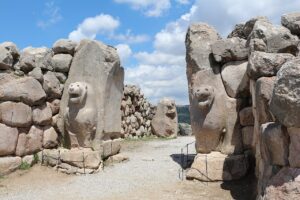
Lion Gate, Hattusa. By Bernard Gagnon – Own work, CC BY-SA 3.0, https://commons.wikimedia.org/w/index.php?curid=37792370
A Late Bronze Age City
Little remains of magnificent ancient Hattusas, the seat of the great Hittite Empire during the middle of the second millennium B.C. The city was once protected by stone walls nearly four miles long, their gateways decorated with intricate relief carvings. The King’s Gate (photo above) bears an impressive regal-like carving—though this gate is misnamed, for the figure actually depicts a Hittite war god.
Among the Hattusas finds are documents and seals in the Hittite language, sinuous statues of deities and humans, incense burners and fine pottery. In addition to distinctive Hittite characteristics, these objects show the influences of Egypt, Assyria and the Aegean—a virtual map of the Hittite empire’s international reach. Also found near Hattusas are mysterious hieroglyphic rock inscriptions, which may date to before the Hittites borrowed Akkadian cuneiform from the Assyrians.
Read the rest of Expeditions: Hattusas, Turkey in the online Biblical Archaeology Society Library.